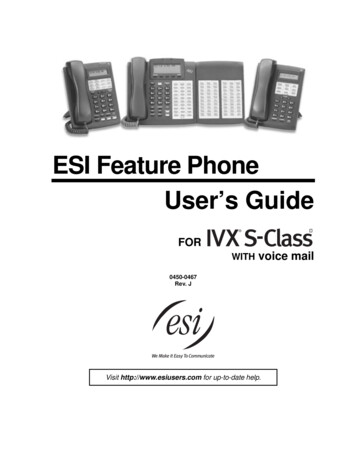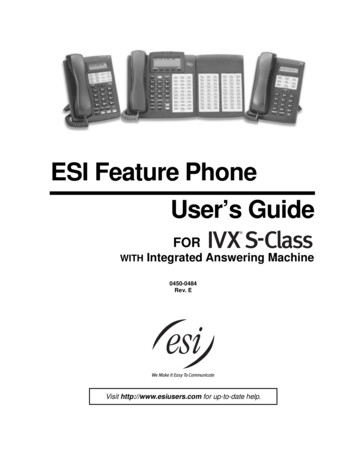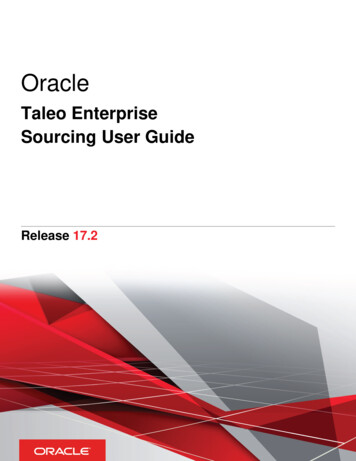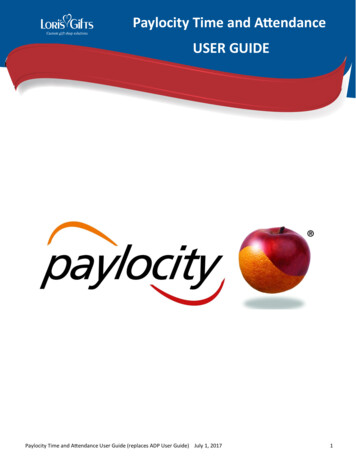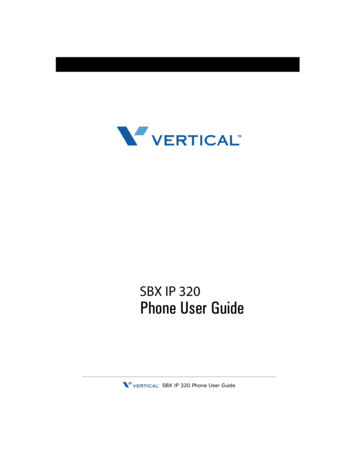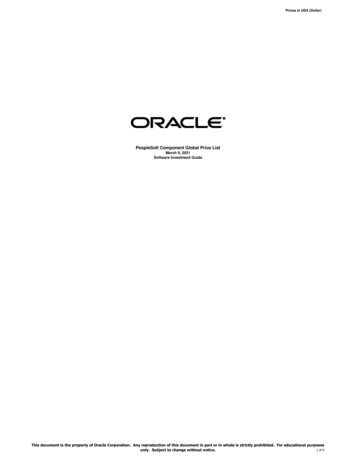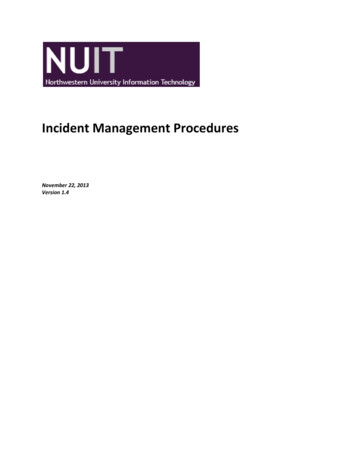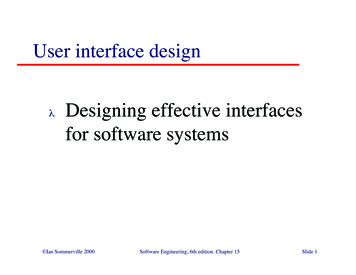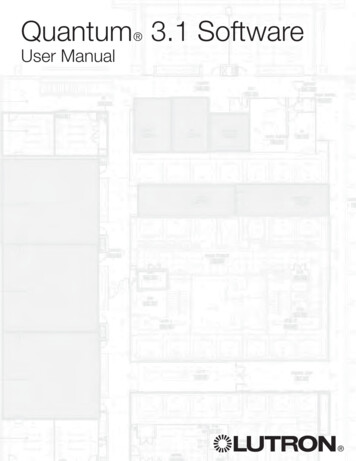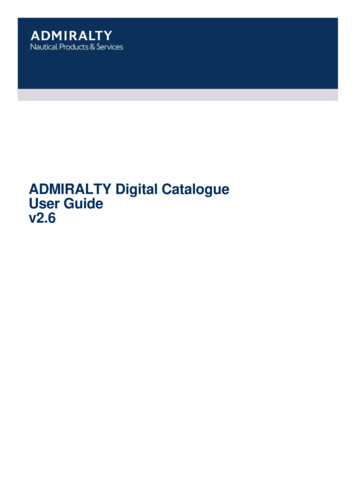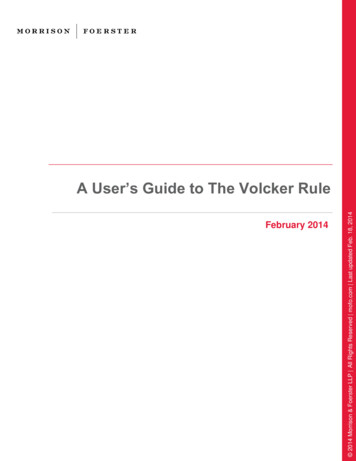
Transcription
February 2014 2014 Morrison & Foerster LLP All Rights Reserved mofo.com Last updated Feb. 18, 2014A User’s Guide to The Volcker Rule
Table of ContentsSummary .3SUBPART B – Proprietary Trading .5SUBPART C – Covered Funds Activities and Investments .11SUBPART D – Compliance Programs .24APPENDIX A – Reporting and Recordkeeping Requirements forCovered Trading Activities .25APPENDIX B – Enhanced Minimum Standards for Compliance Program.272
SummaryThe legislation known as the Volcker Rule was enacted as part of the Dodd-FrankWall Street Reform and Consumer Protection Act and codified in Section 13 of theBank Holding Company Act of 1956, as amended (“BHC Act”).1 The Volcker Rulegenerally prohibits, subject to exceptions, a banking entity from engaging inproprietary trading and from acquiring or retaining an ownership interest in orsponsoring a hedge fund or private equity fund. Certain trading and fund activity isexpressly permitted – notably, underwriting activities, market making-relatedactivities, and risk-mitigating hedging activities.The Volcker Rule legislation covered the area with a broad brush, leaving manysignificant issues open to regulatory interpretation. In December 2013, five federalfinancial regulatory agencies (collectively, the “Agencies”),2 adopted a final rule(the “Final Rule”) construing the Volcker Rule.3 The Final Rule also sets out acompliance and reporting regime for banking entities engaged in proprietary tradingor fund sponsorship or investment. The determinations made by the Agencies in theFinal Rule reflect two years of comment and debate following the issuance of aProposed Rule (the “Proposed Rule”) in November 2011.Under the Final Rule, larger banks and bank affiliates (based on total assets) that areengaged in proprietary trading permitted by the Final Rule will be subject to acompliance regime to ensure compliance with the Final Rule. In addition, largerbanks and bank affiliates (in terms of the amount of their trading assets andliabilities) that are engaged in proprietary trading permitted by the Final Rule will berequired to report a highly technical set of quantitative measures. Banking entitieswith only a “modest” level of trading and fund investment activities will be subjectto a much less comprehensive set of compliance requirements. The compliancerequirements are discussed in more detail below.The Final Rule is complex in scope and has already elicited significant commentaryand questions from the banking industry and the public at large. The purpose of thisguide is to discuss the requirements of the Final Rule at a practical level. While therelevant components of the Final Rule are addressed here, financial institutionsshould consider all of the Final Rule’s “fine print” – the many detailed definitionsand conditions that comprise the Final Rule (as well as the extensive commentary1Section 619 of the Dodd-Frank Wall Street Reform and Consumer Protection Act, Pub. L. No. 111-203,124 Stat.1376 (July 21, 2010) (“Dodd-Frank” or the “Act”); Section 13 of the Bank Holding Company Act(“BHC Act”), 12 U.S.C. § 1851.2The Federal Deposit Insurance Corporation (“FDIC”), the Federal Reserve Board (“FRB”), the Office ofthe Comptroller of the Currency (“OCC”), the Securities and Exchange Commission (“SEC”), and theCommodity Futures Trading Commission (“CFTC”).3The Final Rule may be foundat eg/bcreg20131210a1.pdf. The Final Rule wasaccompanied by a long explanatory commentary (“Attachment B”). Attachment B may be foundat eg/bcreg20131210a2.pdf.3
contained in Attachment B to the Final Rule) – before making any decisionsregarding compliance.The Volcker Rule, as construed by the Final Rule, has special application to foreignbanking organizations that have U.S. bank subsidiaries or operate branches, agenciesor commercial lending company subsidiaries in the United States (“FBOs”). Pleaserefer to our Client Alert dated December 12, 2013 for a more complete explanationof the impact of the Final Rule on FBOs. The Client Alert may be found Volcker-Rule.pdf.The Conformance PeriodThe Final Rule is effective April 1, 2014, but the compliance period during whichbanking entities must conform their activities to the Volcker Rule has been extended forone year until July 21, 2015. Nonetheless, effective June 30, 2014, the largest bankingentities (those with 50 billion or more in consolidated trading assets and liabilities, asdiscussed further below) are required to report quantitative measurements to regulators.The FRB emphasized in its order approving the extension of the conformance period thateach banking entity is expected to engage in good-faith efforts, appropriate for itsactivities and investments, that will result in conformance with the Volcker Rule not laterthan the end of the conformance period. Moreover, banking entities should not expandactivities or make investments during the conformance period with an expectation thatadditional time to conform those activities or investments will be granted, and bankingentities with stand-alone proprietary trading operations are expected to promptlyterminate or divest such operations.Banking EntitiesThe Volcker Rule applies to “banking entities.” A “banking entity” includes:(i)(ii)(iii)(iv)any insured depository institution;any company that controls an insured depository institution (in otherwords, any bank holding company or savings and loan holding company);any FBO; andany affiliate of the foregoing. The term “affiliate” is used as defined in theBHC Act and thus includes any company controlled by a banking entity.Notwithstanding the breadth of the definition of a “banking entity,” there are certainspecific exceptions. For example, a “banking entity” does not include a covered fund thatis not itself a bank holding company or an FBO. This is an important exception. A bankholding company that serves as the general partner of a fund would be deemed to controlthat fund. But for this exception, the “covered fund” would itself be a “banking entity”subject to the Volcker Rule.4
In addition, a “banking entity” does not include a portfolio company held by a bankholding company or an FBO under the so-called BHC Act’s merchant banking authority,4a company controlled by an insurance company affiliate of a bank holding company,5 orany portfolio concern that is controlled by a small business investment company, asdefined in Section 103(3) of the Small Business Investment Act of 1958, as long as theportfolio company or portfolio concern is not itself an insured depository institution, abank holding company or savings and loan holding company, or an FBO.SUBPART B6 – Proprietary TradingThe Volcker Rule prohibits a banking entity from engaging in proprietary trading, subjectto certain exceptions discussed below. Proprietary trading is defined as engaging asprincipal for the trading account of the banking entity in the purchase or sale of afinancial instrument. Thus, compliance with the Rule by a banking entity depends onwhether the account for which the trade is placed satisfies the definition of “tradingaccount” and whether the trade involves a “financial instrument.”DefinitionsTrading Account. The Final Rule provides a functional definition of “trading account,”which means an account that satisfies any one of three criteria: a “purpose test,” a“market risk capital rule test,” or a “status test.”The Purpose Test. A trading account includes any account used by a bankingentity to buy or sell a financial instrument principally for the purpose of shortterm resale, benefitting from actual or expected short-term price movements,realizing short-term arbitrage profits, or hedging a position resulting from any ofthe foregoing trading activities.Market Risk Capital Rule Test. If the banking entity or any affiliate is an insureddepository institution, bank holding company, or savings and loan holdingcompany and calculates risk-based capital ratios under the U.S. market riskcapital rule, a trading account includes accounts used to buy or sell one or morefinancial instruments that are both market risk capital rule covered positions andtrading positions (or hedges of other market risk capital rule covered positions).Status Test. If the banking entity is licensed or registered (or required to belicensed or registered) to engage in the business of a securities dealer, swap dealeror security-based swap dealer, a trading account includes any account used by abanking entity to purchase or sell financial instruments for any purpose to theextent the financial instruments are purchased or sold in connection with activitiesthat require the banking entity to be so licensed or registered.412 U.S.C.§ 1843(k)(4)(H).12 U.S.C. § 1843(k)(4)(I).6The Volcker Rule is 71 pages long and consists of Subparts A through D and Appendices A and B.Subpart A is titled “Authority and Definitions,” and is not discussed directly here.55
Trades are presumed to be for the trading account of a banking entity if the banking entityholds the position for fewer than sixty days, unless the banking entity can demonstratethat it did not make the trade for any of the purposes described in the precedingparagraph.As the definition of a trading account is broad, the Rule excludes the following types oftrading from the definition of proprietary trading: Trades pursuant to purchase or reverse repurchase agreements;Trades that arise under a transaction in which the banking entity lends or borrowssecurities temporarily under an agreement pursuant to which the lender retains theeconomic interest in the securities, and has the right to recall the loaned securities;Trades for the purpose of liquidity management in accordance with a documentedliquidity management plan that meets specific requirements of the Final Rule;7Trades by a derivatives clearing organization or clearing agency in connectionwith clearing or settlement of financial instruments;Any “excluded clearing activities”8 by a banking entity that is a member of aclearing agency, a member of a derivatives clearing organization or a member of adesignated financial market utility;Trades to satisfy an existing delivery obligation, including to prevent or close outa failure to deliver, in connection with delivery, clearing or settlement activity;Trades to satisfy an obligation in connection with a judicial, administrative orself-regulatory organization or arbitration proceeding;Trades where the banking entity is acting solely as agent, broker or custodian;Trades through a deferred compensation, stock-bonus, profit-sharing or pensionplan of the banking entity; andTrades made in the ordinary course of collecting a debt previously contracted(“DPC”) in good faith, provided that the banking entity divests the financialinstrument as soon as practicable.7The liquidity management plan should:(i) specifically contemplate and authorize the particular securities to be used for liquiditymanagement purposes, the amount, types, and risks of these securities that are consistent withliquidity management, and the circumstances in which the securities may be used;(ii) require that any transaction in securities under the plan be principally for the purpose ofliquidity management and not for short-term price movements, resale, profits or arbitrage;(iii) require that any securities purchased or sold for liquidity management purposes be highlyliquid and limited to securities the risks of which the banking entity does not reasonably expect togive rise to appreciable profits or losses in the short term;(iv) limit any securities and other instruments purchased or sold for liquidity managementpurposes to an amount consistent with the banking entity’s near-term funding needs;(v) includes written policies and procedures, internal controls, analysis and independent testing toensure that transactions in securities other than domestic or foreign government obligations are forthe purpose of liquidity management; and(vi) be consistent with the relevant Agency’s supervisory requirements regarding liquiditymanagement.8Final Rule, § .3(e)(7).6
Trades between affiliates are not specifically excluded from the definition of proprietarytrading and therefore must rely on a stated exception.Financial Instrument. A “financial instrument” includes: a security (including an option on a security); a derivative (including an option on a derivative); and a contract of sale of a commodity for future delivery (or an option on the same).Specifically excluded from the definition of “financial instrument” are: loans;a commodity that is not (i) an “excluded commodity”9 (other than foreignexchange or currency), (ii) a derivative, or (iii) a commodity future; andforeign exchange or currency.Permitted underwriting and market making-related activitiesThe prohibition against proprietary trading does not apply to permitted underwritingactivities and market making-related activities. Significant comment was provided to theAgencies after the publication of the Proposed Rule regarding how best to distinguishthese permitted activities from prohibited proprietary trading. The Final Rule enumeratesdetailed conditions for qualifying as permitted underwriting or market-making. The longcommentary published with the Final Rule in Attachment B provides useful insights intothe view of the Agencies regarding the distinctive features of these permitted activities.This guide is intended as a summary only.9An “excluded commodity” is as defined in Section 1a(19) of the Commodity Exchange Act, 7 U.S.C.1a(19). “The term “excluded commodity” means—(i) an interest rate, exchange rate, currency, security, security index, credit risk or measure, debt orequity instrument, index or measure of inflation, or other macroeconomic index or measure;(ii) any other rate, differential, index, or measure of economic or commercial risk, return, or valuethat is—(I) not based in substantial part on the value of a narrow group of commodities notdescribed in clause (i); or(II) based solely on one or more commodities that have no cash market;(iii) any economic or commercial index based on prices, rates, values, or levels that are not withinthe control of any party to the relevant contract, agreement, or transaction; or(iv) an occurrence, extent of an occurrence, or contingency (other than a change in the price, rate,value, or level of a commodity not described in clause (i)) that is—(I) beyond the control of the parties to the relevant contract, agreement, or transaction;and(II) associated with a financial, commercial, or economic consequence.”7
To engage in either permitted activity, a banking entity must comply with three overallconditions: the banking entity must maintain an internal compliance program required bySubpart D (and discussed below) to ensure that the banking entity complies withthe conditions permitting the activity;the compensation arrangements of people involved in these activities must not bedesigned to reward or incentivize prohibited proprietary trading; andthe banking entity must be licensed or registered to engage in the permittedactivity.In addition, the following specific conditions apply.Underwriting. Underwriting activities are permitted only if the trading desk’s10underwriting position is related to a “distribution” of securities for which the bankingentity is acting as underwriter.11 The amount and type of the securities in theunderwriting position cannot exceed the reasonably expected near term demands ofclients, customers or counterparties, and the trading desk must make reasonable efforts toreduce the underwriting position within a reasonable period.The Final Rule defines “distribution” to include offerings of securities made pursuant to aregistration statement under the Securities Act of 1933 (the “1933 Act”), as well asofferings whether or not pursuant to the 1933 Act that involve special selling efforts andselling methods.12The Final Rule defines “underwriter” broadly as well, to include a person who has agreedto purchase securities from an issuer or selling security holder for distribution, or engagein or manage a distribution of securities for or on behalf of the issuer or selling securityholder, as well as a person who has agreed to participate or is participating in adistribution of securities on behalf of the issuer or selling security holder.The compliance program described below is a condition for permitted underwriting. Thecompliance program must include written policies and procedures, internal controls,analysis and independent testing identifying and addressing: the products, instruments or exposures each trading desk may trade or manageas part of its underwriting activities;10A “trading desk” is the smallest discrete unit of organization of a banking entity that purchases or sellsfinancial instruments for the trading account of the banking entity. Final Rule, § .3(e)(13).11Final Rule, § .4(a).12The definition of “distribution” tracks in some respects the definition provided in Regulation M under theSecurities Exchange Act of 1934 (the “Exchange Act”), 17 CFR § 242.100 to105, but excludes the need toconsider the “magnitude” of the offering. Thus, permitted underwriting activities include activities relatedto 1933 Act registered offerings as well as private placements, Rule 144A offerings, commercial paperofferings, and syndicate and stabilizing activities. Attachment B provides a useful discussion of the typesof offerings, as well as the types of syndicate and related stabilizing activities, which are intended to beincluded.8
limits for each trading desk based on the nature and amount of itsunderwriting activities, taking into account the amount, types and risk of itsunderwriting position; the level of exposures to relevant risk factors arisingfrom its underwriting position; and the period of time a security may be held;internal controls and ongoing monitoring and analysis of compliance withlimits; andauthorization procedures, including escalation procedures, that require reviewand approval of any trade exceeding limits, demonstrable analysis of the basisfor an increase in a trading desk’s limits and independent review of suchanalysis and approval.Market-making. Market making-related activities are permitted only if the relevanttrading desk13 routinely stands ready to purchase and sell one or more types of financialinstruments related to its financial exposure and is willing and available to quote,purchase or sell those types of financial instruments for its own account in commerciallyreasonable amounts and throughout market cycles on a basis appropriate for the liquidity,maturity and depth of the market for the relevant types of financial instruments.14 Inaddition, the amount, types and risks of the financial instruments in the trading desk’smarket-maker inventory must be designed not to exceed the reasonably expected nearterm demands of clients, customers, or counterparties, based on: the liquidity, maturity, and depth of the market for the relevant types offinancial instruments; anddemonstrable analysis of historical customer demand, current inventory offinancial instruments, and market and other factors regarding the amount,types, and risks, of or associated with financial instruments in which thetrading desk makes a market, including through block trades.The Final Rule establishes a rebuttable presumption that the trading desk of anotherbanking entity with trading assets and liabilities exceeding 50 billion is not a “client,customer, or counterparty” for the purposes of considering whether trading with that deskis permitted market making. In Attachment B, the Agencies recognize, however, thatallowing a trading desk to engage in customer-related interdealer trading is appropriatebecause it can help a trading desk appropriately manage its inventory and risk levels andcan effectively allow clients, customers, or counterparties to access a larger pool ofliquidity. However, regulators will scrutinize interdealer trading to ensure it reflectsmarket-making activities and not impermissible proprietary trading.The compliance program described below is a condition for permitted market making.The compliance program is required to include written policies and procedures, internalcontrols, analysis and independent testing addressing: 1314instruments in which each trading desk will make a market;See note 10 supra.Final Rule, § .4(b).9
actions the trading desk will take to demonstrably reduce or otherwisesignificantly mitigate promptly the risks of its financial exposure;limits for each trading desk, based on the nature and amount of the tradingdesk’s market making-related activities;internal controls and ongoing monitoring and analysis of each tradingdesk’s compliance with its limits; andauthorization procedures, including escalation procedures, that requirereview and approval of any trade that would exceed a trading desk’slimit(s), demonstrable analysis that the basis for any increase to a tradingdesk’s limits is consistent with the market making exception requirementsand independent review of such analysis and approval.Permitted risk-mitigating hedging activities: The prohibition on proprietary tradingdoes not apply to certain risk-mitigating hedging activities. Section .5(a) of the FinalRule permits, subject to numerous conditions, hedging activities that are “in connectionwith and related to individual or aggregated positions, contracts or other holdings” and“designed to reduce the specific risks to the banking entity” that are “related to suchpositions, contracts or other holdings.”15 Hedging of general risks that are not related tospecific positions, such as risks associated with assets or liabilities of the banking entitygenerally or risks associated with general market movements or broad economicconditions, is not permitted.The compliance program described below is a condition for any risk-mitigating hedgingactivity to be permissible. The compliance program is required to include, among otherthings: written policies and procedures regarding positions, techniques and strategies thatmay be used for hedging;documentation indicating what positions, contracts or other holdings a particulartrading desk may use in its hedging activities;position and aging limits; andinternal controls and authorization procedures (including relevant escalationprocedures) and analysis, including correlation analysis, and independent testingdesigned to ensure that the positions, techniques and strategies that may be usedfor hedging may reasonably be expected to demonstrably reduce or otherwisesignificantly mitigate the specific, identifiable risks being hedged, and thecorrelation analysis demonstrates that the hedging activity demonstrably reducesor otherwise significantly mitigates the specific, identifiable risks being hedged.15Hedging in conjunction with market making activities is not subject to, and need not satisfy, therequirements for permitted risk-mitigating hedging activities. However, such hedging must stilldemonstrably reduce or otherwise significantly mitigate one or more specific risks; the trading desk that isengaged in market making must also conduct or direct the hedge (hedges put on by another trading desk aresubject to the permitted risk-mitigating hedging activities requirements); and the written policies andprocedures addressing permissible hedging techniques and strategies for market making must specify howthe trading desk may establish hedges, how such hedges are removed once the risk they are mitigating isunwound and the extent to which the trading desk will engage in anticipatory hedging.10
Risk-mitigating hedging activities must not give rise, at the inception of a hedge, to anysignificant new or additional risk that is not itself hedged contemporaneously, andcontinuing review, monitoring and management of hedging activity, and ongoingrecalibration of the hedging activity, is required. The Final Rule imposes additionaldocumentation requirements with respect to risk-mitigating hedging activities establishedby a trading desk other than the desk responsible for the underlying positions and withrespect to hedges of aggregated positions across trading desks, as well as hedgingactivities that are effected through financial instruments, exposures, techniques orstrategies not specifically identified in applicable policies and procedures.Anticipatory and dynamic hedging activities are permitted so long as they meet the aboverequirements.Other permitted proprietary trading activitiesThe prohibition on proprietary trading does not apply to the following: trading in U.S. government or government agency securities;trading in municipal bonds;trading by a foreign affiliate of a U.S. banking entity of debt of a foreignsovereign (including any multinational central bank of which the foreignsovereign is a member), or of any agency or political subdivision of that foreigngovernment, issued by the foreign country in which the foreign affiliate isorganized, if the affiliate is a foreign bank or regulated by the foreign sovereign asa securities dealer and the trading is not financed by an affiliate located in theUnited States or organized under U.S. law;trading on behalf of a customer in a fiduciary capacity or as riskless principal; andtrading by a banking entity that is a regulated insurance company (including aforeign insurance company), whether for the insurance company’s generalaccount or for a separate account.Exemptions for Foreign Banking EntitiesThe Final Rule establishes an exemption for proprietary trading by certain foreignbanking entities to the extent the trading is conducted solely outside the United States. Inaddition, certain U.S. affiliates of certain foreign banking entities are permitted to engagein proprietary trading of debt of the foreign country (or its agencies or politicalsubdivisions) under which the foreign banking entity is organized. These twoexemptions are discussed at greater length in our Client Alert available Volcker-Rule.pdf.Prudential BackstopsThe permitted proprietary trading activities referenced above are not permissible underthe Rule if (i) they would involve or result in a material conflict of interest between the11
banking entity and its clients, customers or counterparties; (ii) they would result in amaterial exposure by the banking entity to a high-risk asset16 or a high-risk tradingstrategy;17 or (iii) they pose a threat to the safety and soundness of the banking entity orto the financial stability of the United States.A material conflict of interest is deemed to exist if the banking entity engages intransactions that would involve or result in the banking entity’s interests being materiallyadverse to the interests of its client, customer or counterparty with respect to suchtransactions, and prior to engaging in such transactions, the banking entity has not madeappropriate disclosures to address the conflict of interest or, in appropriate circumstances,established information barriers memorialized in written policies and procedures, such asphysical separation of personnel or functions or other measures designed to prevent suchconflict of interest.Failure to comply with these prudential backstops can take away the availability of whatotherwise appears to be a clearly available trading exemption. This is worrisome in thatthere are no clear guidelines regarding the measures a banking entity is required to takewith respect to any given activity to assure compliance. In particular, it will be difficultfor banking entities to know what would constitute adequate disclosure to deal with apotential conflict of interest, and what kind of information barriers would be appropriatein particular circumstances. In addition, the incurrence of a substantial financial loss in apermitted trading activity, regardless of the compliance framework in which the activityis conducted, bears the risk, in hindsight, that the activity will be characterized as “highrisk,” with the consequence of losing the exemption relied on for the activity.SUBPART C – Covered Funds Activities and InvestmentsThe Volcker Rule prohibits a banking entity, as principal, directly or indirectly, fromacquiring or retaining an ownership interest in or sponsoring a “covered fund.” Theprohibition does not extend to the acquisition of ownership interests by a banking entity: acting solely as agent, broker or custodian, so long as the activity is conducted forthe account of, and on behalf of, a customer, and the banking entity and itsaffiliates do not retain beneficial ownership in such ownership interest; through a deferred compensation, stock bonus, profit-sharing or pension plan ifthe ownership interest is held or controlled by the banking entity as trustee for thebenefit of present or former employees of the banking entity or an affiliate; in the ordinary course of collecting a debt previously contracted (subject to certainconditions); or on behalf of customers as trustee or in a similar capacity for a customer that is nota covered fund, so long as the activity is conducted for the account of, and on16An asset that would, if held by a banking entity, significantly increase the likelihood that the bankingentity would incur a substantial financial loss or would pos
SUBPART B6 - Proprietary Trading The Volcker Rule prohibits a banking entity from engaging in proprietary trading, subject to certain exceptions discussed below. Proprietary trading is defined as engaging as principal for the trading account of the banking entity in the purchase or sale of a financial instrument.

